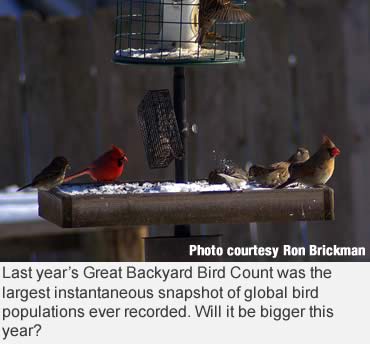For avian fans, it’s bird watching time all the time, but this time of year finds many people investigating how their pleasant pastime of bird-feeder observations can become part of a citizen scientist effort.
They won’t need to look very far.
From November through February, there is an abundance of national and state projects for bird watching and counting. Many state Departments of Natural Resources sponsor winter bird counts, and well-known groups of bird watching scientists have programs designed for those who to love watching their backyard bird feeders.
Project FeederWatch
If you’re interested in counting birds and noting their presence in your yard, you can help scientists track long-term trends in bird distribution and abundance by becoming involved with Project FeederWatch.
 FeederWatch, which lasts from November through April, is conducted by people of all skill levels and backgrounds, including children, families, individuals, classrooms, retired persons, youth groups, nature centers and bird clubs.
FeederWatch, which lasts from November through April, is conducted by people of all skill levels and backgrounds, including children, families, individuals, classrooms, retired persons, youth groups, nature centers and bird clubs.
Participants can count birds as often as every week, or as infrequently as they like; the schedule is completely flexible. All that’s needed is a bird feeder, bird bath, or plantings that attract birds. New participants are sent a research kit with complete instructions, a bird identification poster, calendar and more.
All those observations become part of a much larger effort of scientific discovery, according to the Cornell Lab of Ornithology, sponsor of the project.
119th Christmas Bird Count
Sign up now, because by December, you can join America’s longest running community science bird project—the Audubon Christmas Bird Count.
The 119th Christmas Bird Count takes place between Dec. 14, 2018 and Jan. 5, 2019. Each November, birders interested in participating can sign up through the Audubon website.
During the three-week period each year, tens of thousands of volunteers brave snow, wind or rain, and take part in the effort. Audubon and other organizations use data collected in this long-running wildlife census to assess the health of bird populations, and to help guide conservation action.
Great Backyard Bird Count
Wait! There’s one more, and there will still be time to join the Great Backyard Bird Count!
 For a little as 15 minutes of your time in your own backyard, from Feb. 15 through 18, 2019, you can expand your understanding of birds and submit your checklist to researchers at the Cornell Lab of Ornithology.
For a little as 15 minutes of your time in your own backyard, from Feb. 15 through 18, 2019, you can expand your understanding of birds and submit your checklist to researchers at the Cornell Lab of Ornithology.
Even that 15 minutes in your own backyard to help grow our understanding of birds because the bird checklist will be submitted to help researchers at the Cornell Lab of Ornithology.
During last year’s Great Backyard Bird Count, more than 160,000 participants submitted their bird observations online, creating the largest instantaneous snapshot of global bird populations ever recorded. That was pretty impressive.
And, about those bird feeders
A few thoughts for backyard bird watchers about keeping your feeders clean and birds healthy.
The Cornell Lab of Ornithology has noted that a recent study done by researchers at a university in Pennsylvania discovered the most effective way to reduce salmonella bacteria in wild bird feeders was to keep your feeders clean.
They recommend, at a minimum, when you clean your bird feeders to completely remove all visible debris, and they really mean completely. Then soak or scrub the feeders with a bleach solution and let them dry completely before adding your bird seed. Preventing the spread of disease means to regularly clean your feeders.
For more about cleaning feeders, click here.